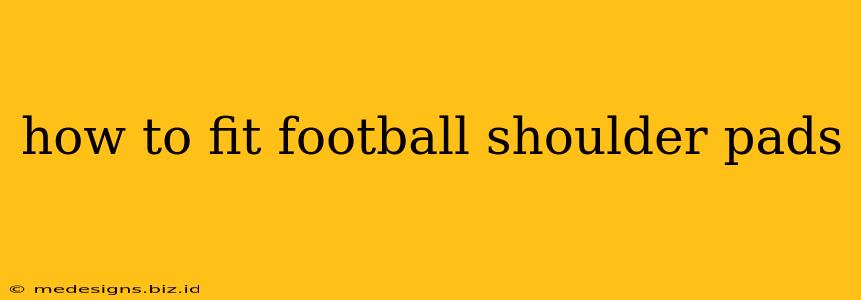Finding the right fit for your football shoulder pads is crucial for both performance and injury prevention. Ill-fitting pads can restrict movement, cause discomfort, and leave you vulnerable to injury. This guide will walk you through how to ensure your shoulder pads fit correctly and comfortably.
Understanding Shoulder Pad Anatomy
Before we dive into fitting, let's understand the key components of football shoulder pads:
- Shoulder Caps: These protect your shoulders and collarbones. A proper fit here is essential for preventing dislocations and sprains.
- Chest Plate: This provides protection for your chest and ribs. It should fit snugly but not restrict breathing.
- Neck and Collar Area: This area needs to be comfortable and secure, allowing for full range of motion without chafing.
- Arm Pads: These protect your biceps and triceps. They should allow for full arm movement without feeling constricted.
- Back Plate: This supports your back and spine. It should offer adequate protection without being overly bulky.
Steps to Properly Fitting Football Shoulder Pads
1. Choosing the Right Size: Start by determining your size using a manufacturer's size chart. These charts usually consider your height, weight, and chest measurements. It’s important to consult multiple charts since sizing varies between brands. Don't be afraid to try on multiple sizes.
2. Putting on the Pads: Start by placing the shoulder pads on your shoulders. Ensure the shoulder caps align correctly with your shoulder joints. The chest plate should sit comfortably against your chest without feeling too tight or loose.
3. Adjusting the Straps: Most shoulder pads have several adjustable straps. These straps control the fit and level of protection. Tighten the straps gradually until the pads feel snug but not restrictive. Experiment with different strap tightness to find the optimal balance.
4. Checking the Fit:
- Shoulder Movement: Raise your arms, and swing them around. The pads should move with you without feeling constrictive or binding.
- Breathing: Take deep breaths. You should be able to breathe comfortably with the pads on.
- Range of Motion: Twist and turn your body. Your movements shouldn’t be hindered by the pads.
- Comfort: The pads should feel snug and secure but not uncomfortable or painful. Any areas of excessive pressure or chafing indicate a poor fit.
5. Consider the Type of Play: The type of football you play (e.g., lineman, receiver, defensive back) will influence the type of padding you need. Linemen generally require more padding, while receivers and defensive backs may prefer lighter, more mobile pads.
6. Professional Advice: If you are unsure about the proper fit, seek the assistance of a qualified sporting goods specialist or equipment fitter. They can help you find the correct size and adjust your pads for optimal comfort and performance.
Common Fitting Issues and Solutions
- Pads too loose: Tighten the straps and consider going down a size. Loose pads offer inadequate protection.
- Pads too tight: Loosen the straps. Tight pads can restrict movement and cause discomfort.
- Shoulder caps too far forward: Adjust the straps to pull the shoulder caps back over your shoulders.
- Chafing or rubbing: Try adjusting the straps or using padding under the pads to reduce friction.
Maintaining Your Shoulder Pads
Proper maintenance is key to extending the life of your pads and ensuring they continue to fit well. Always air them out after each use and clean them periodically according to the manufacturer's instructions. Regular inspection will help you detect any wear and tear.
By following these guidelines, you can significantly improve the comfort and protection provided by your shoulder pads, leading to a better overall performance and reduced risk of injury. Remember, safety and comfort should be top priorities when selecting and fitting your equipment.
